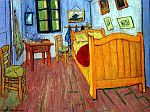 |
 |
Whatever objects are in a room, the characteristic aspect is always light. Hence, if we assign an activity or purpose to a room but do not rightly account for light, the activity is subtly undermined. Light is not just an issue of brightness or color but source. An artiificial source of light projects the artifice of the room’s purpose — or the artifice of its occupant’s activity.
A room is created by light, and as that light dims so to the activity that depended on light. The obvious example might be reading or something involving vision.
Light is relevant to our room because the solitary spends a great deal of effort accommodating to existence in a room. Whatever the size of the room, its intimacy for solitude makes the room reflect the degree of our projected thoughts. That is why open spaces outdoors in a natural setting can open our minds so much, while small and confined spaces of our own making can usefully allow us to concentrate our minds. Light can amplify the bad effects or compliment the good ones. Smaller spaces require less light for thought and concentrated light for concentration (as in reading or writing).
Natural light carries with it the sense of open space. All of the indoor settings of 17th-century Dutch painter Jan Vermeer, for example, are full of natural light, which makes for a sense of harmony with whatever is just outside the window. The lighted space is not intimate as such but is connected. Or perhaps that sense of connection is what makes the room more intimate, or at least hospitable. Contrast this with a famous painting of Vincent van Gogh, where the source of light in the room is harsh, intrusive, overwhelming — as its occupant would doubtless have felt.
One doesn’t have to be a designer to appreciate light in our rooms. How light makes us feel is enough of a criterion.